Design principles for billion-level concurrent system architecture

1. The main goals of architecture design
1. High performance: A concurrent system with hundreds of millions of requests must be able to handle a large number of concurrent requests, so high performance is the primary goal when designing the architecture. This includes optimizing the system's response time, throughput, and resource utilization to ensure that the system remains stable and efficient even when facing extreme loads.
2. Scalability: With the development of business and the growth of users, the system needs to be able to flexibly expand to adapt to higher concurrency requirements. The architecture design should take into account the possibility of horizontal and vertical expansion, and improve the scalability of the system through modularization, service-oriented and other design methods.
3. Reliability: A system with billions of concurrent users must be highly reliable and able to provide stable services even in the event of hardware failures, network anomalies, etc. This requires full consideration of fault tolerance, disaster recovery, and data backup mechanisms in the architecture design to ensure stable system operation and data security.
4. Ease of maintenance: As the scale and complexity of the system increase, the maintenance cost will also rise accordingly. Therefore, when designing the architecture, we should focus on the ease of maintenance of the system, and reduce the difficulty of maintenance through reasonable module division, clear interface definition and complete document support.
2. Principles that should be followed in architecture design
1. Principle of simplicity: Under the premise of meeting functional requirements, the architecture should be kept as simple as possible. Simple architecture is easier to understand and maintain, and also helps reduce potential errors and failure points.
2. Consistency principle: Ensure that the entire system is consistent in design style, data format, and interaction mode. This helps improve the integrity and collaborative efficiency of the system and reduce confusion and errors during development and maintenance.
3. Flexibility principle: The architecture design should have a certain degree of flexibility to adapt to possible changes and demand adjustments in the future, including supporting dynamic expansion of functions, smooth upgrading of technology, and innovation of business models.
4. Security principle: In the system architecture design, security factors must be fully considered, including data transmission security, user identity authentication and authorization, prevention of malicious attacks, etc. By adopting appropriate security technologies and strategies, the security of the system and the privacy protection of users can be ensured.
The architectural design of a billion-level concurrent system is a complex and critical task. By clarifying the main design goals and principles to follow, architects can better meet challenges and build a high-performance, scalable, reliable and easy-to-maintain system architecture to support the development needs of modern Internet applications.
3. Common Architecture Design Patterns
In system architecture design, there are many common architecture design patterns, which provide designers with effective methods and ideas for solving specific problems.
The following is a detailed overview of several commonly used architectural design patterns.
The layered architecture pattern is a design method that divides an application into different layers. Each layer is responsible for a specific function and interacts with the upper and lower layers through interfaces. A typical layered architecture includes a presentation layer, a business logic layer, and a data access layer. The advantages of this pattern are that it has a clear structure, is easy to manage and maintain, and facilitates division of labor and cooperation between teams.
Taking the e-commerce platform as an example, in its architectural design, the presentation layer focuses on the presentation of the user interface and the processing of interaction logic, the business logic layer is responsible for processing core business logic such as order management and product information, and the data access layer is responsible for interacting with the database to realize data storage, retrieval and update.

The microservice architecture pattern is an architectural design pattern that has emerged in recent years. It splits an application into a series of small, independent services, each of which runs in its own process and interacts through lightweight communication mechanisms. The advantage of this pattern is that it improves the scalability, flexibility, and maintainability of the system. Each microservice can be deployed and upgraded independently, thus achieving rapid iteration and continuous delivery of the system.
Taking the e-commerce platform as an example, functions such as user management, product management, and order management can be split into independent microservices, and each service can be developed and maintained by a dedicated team.

The event-driven architecture pattern is an event-based communication method that allows different components or services to interact by publishing and subscribing to events. This pattern can achieve loose coupling and high availability of the system because the components do not directly depend on each other but communicate through events. When a component fails, other components can still work normally, thereby improving the fault tolerance of the system.
In e-commerce platforms, event-driven architecture can be used to handle business processes such as user ordering, payment, and delivery to ensure smooth collaboration between various links.


In addition to the above three patterns, service-oriented architecture (SOA) is also a common architectural design pattern. SOA divides applications into a series of independent services that communicate through well-defined interfaces. Similar to microservice architecture, SOA also emphasizes the independence and reusability of services, but usually the granularity of services is larger and more focused on enterprise-level application integration.

In practical applications, these architecture design patterns do not exist in isolation, but can be combined and complemented with each other. Designers need to choose appropriate architecture design patterns based on specific application scenarios and requirements to ensure the stability, scalability and maintainability of the system. At the same time, with the continuous development of technology and the continuous changes in business needs, architecture design patterns also need to be continuously evolved and optimized.
Common architectural design patterns provide valuable experience and guidance for system architecture design. Designers should have a deep understanding of the principles and application scenarios of these patterns so that they can be flexibly applied in actual projects and achieve the expected design goals.
4. Characteristics and Challenges of High Concurrency Systems
As an important part of modern Internet technology, high-concurrency systems have a series of distinct characteristics and face many challenges. These characteristics and challenges together constitute the core considerations for the design of high-concurrency system architecture.
The characteristics of high-concurrency systems are mainly reflected in the following aspects: First, the number of user requests is large, and the system needs to be able to handle thousands of concurrent requests at the same time to ensure that each user can get timely and accurate service responses. Second, the data throughput is high, and the system needs to efficiently handle a large number of data read and write operations to meet the needs of real-time data processing and analysis. Furthermore, the system has high availability requirements. High-concurrency systems often carry important business functions. Any failure or performance degradation may have a significant impact on the business, so the system needs to have high stability and availability.
High-concurrency systems also face many challenges. On the one hand, as the number of users continues to grow, system scalability becomes the key. How to achieve horizontal or vertical expansion while maintaining system performance to meet growing business needs is one of the important challenges facing high-concurrency systems. On the other hand, the complexity of the system also increases. In a high-concurrency environment, the interactions between the various components of the system become more frequent and complex. How to ensure that the various parts of the system can work together to avoid performance bottlenecks or failure points is also a problem that needs to be solved urgently.
High-concurrency systems also need to consider data consistency and security. In the case of multi-user concurrent operations, how to ensure data consistency and integrity and prevent data conflicts or losses are issues that high-concurrency systems must face. At the same time, with the increasing number of network security threats, high-concurrency systems also need to have strong security protection capabilities to ensure the security of user data and system information.
High-concurrency systems have the characteristics of large user requests, high data throughput, and high system availability requirements. At the same time, they also face challenges in scalability, complexity, data consistency, and security. These characteristics and challenges are intertwined and influence each other, and together constitute the complexity and difficulty of high-concurrency system architecture design. Therefore, when designing a high-concurrency system architecture, these factors need to be fully considered to ensure that the system can meet business needs and have good performance and stability.
In order to meet these challenges, the architectural design of high-concurrency systems needs to follow certain principles and methods.
For example: a distributed architecture design can be used to improve the scalability and availability of the system; reasonable data sharding and redundant backup strategies can be used to ensure data consistency and security; caching, asynchronous processing and other technical means can be used to optimize system performance, etc.
Summarize:
The design of the architecture of a billion-level concurrent system is a complex and critical task that requires balancing high performance, scalability, reliability, and maintainability. By clarifying design goals, such as optimizing response time, throughput, and resource utilization, and following the principles of simplicity, consistency, flexibility, and security, and adopting appropriate architectural patterns (such as layering, microservices, event-driven, or SOA), combined with distributed architecture, data sharding, caching, and asynchronous processing strategies, we can effectively respond to high concurrency challenges and build a stable and efficient system architecture. Of course, to truly realize a billion-level concurrent system architecture, the principles mentioned in this article alone are far from enough.